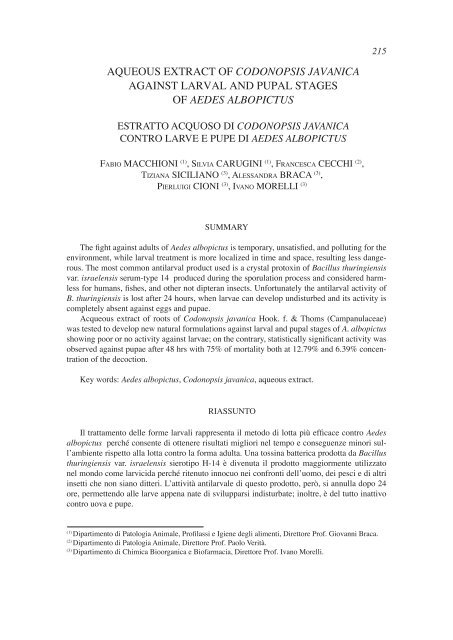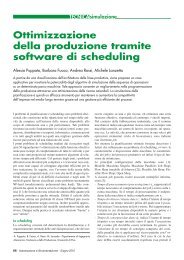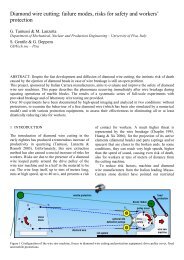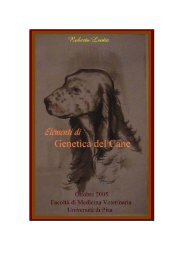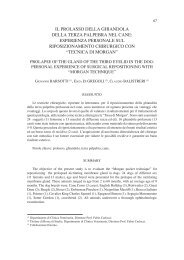aqueous extract of codonopsis javanica against larval
aqueous extract of codonopsis javanica against larval
aqueous extract of codonopsis javanica against larval
Create successful ePaper yourself
Turn your PDF publications into a flip-book with our unique Google optimized e-Paper software.
AQUEOUS EXTRACT OF CODONOPSIS JAVANICA<br />
AGAINST LARVAL AND PUPAL STAGES<br />
OF AEDES ALBOPICTUS<br />
ESTRATTO ACQUOSO DI CODONOPSIS JAVANICA<br />
CONTRO LARVE E PUPE DI AEDES ALBOPICTUS<br />
FABIO MACCHIONI (1) , SILVIA CARUGINI (1) , FRANCESCA CECCHI (2) ,<br />
TIZIANA SICILIANO (3) , ALESSANDRA BRACA (3) ,<br />
PIERLUIGI CIONI (3) , IVANO MORELLI (3)<br />
SUMMARY<br />
(1) Dipartimento di Patologia Animale, Pr<strong>of</strong>ilassi e Igiene degli alimenti, Direttore Pr<strong>of</strong>. Giovanni Braca.<br />
(2) Dipartimento di Patologia Animale, Direttore Pr<strong>of</strong>. Paolo Verità.<br />
(3) Dipartimento di Chimica Bioorganica e Bi<strong>of</strong>armacia, Direttore Pr<strong>of</strong>. Ivano Morelli.<br />
215<br />
The fight <strong>against</strong> adults <strong>of</strong> Aedes albopictus is temporary, unsatisfied, and polluting for the<br />
environment, while <strong>larval</strong> treatment is more localized in time and space, resulting less dangerous.<br />
The most common anti<strong>larval</strong> product used is a crystal protoxin <strong>of</strong> Bacillus thuringiensis<br />
var. israelensis serum-type 14 produced during the sporulation process and considered harmless<br />
for humans, fishes, and other not dipteran insects. Unfortunately the anti<strong>larval</strong> activity <strong>of</strong><br />
B. thuringiensis is lost after 24 hours, when larvae can develop undisturbed and its activity is<br />
completely absent <strong>against</strong> eggs and pupae.<br />
Acqueous <strong>extract</strong> <strong>of</strong> roots <strong>of</strong> Codonopsis <strong>javanica</strong> Hook. f. & Thoms (Campanulaceae)<br />
was tested to develop new natural formulations <strong>against</strong> <strong>larval</strong> and pupal stages <strong>of</strong> A. albopictus<br />
showing poor or no activity <strong>against</strong> larvae; on the contrary, statistically significant activity was<br />
observed <strong>against</strong> pupae after 48 hrs with 75% <strong>of</strong> mortality both at 12.79% and 6.39% concentration<br />
<strong>of</strong> the decoction.<br />
Key words: Aedes albopictus, Codonopsis <strong>javanica</strong>, <strong>aqueous</strong> <strong>extract</strong>.<br />
RIASSUNTO<br />
Il trattamento delle forme <strong>larval</strong>i rappresenta il metodo di lotta più efficace contro Aedes<br />
albopictus perché consente di ottenere risultati migliori nel tempo e conseguenze minori sull’ambiente<br />
rispetto alla lotta contro la forma adulta. Una tossina batterica prodotta da Bacillus<br />
thuringiensis var. israelensis sierotipo H-14 è divenuta il prodotto maggiormente utilizzato<br />
nel mondo come larvicida perché ritenuto innocuo nei confronti dell’uomo, dei pesci e di altri<br />
insetti che non siano ditteri. L’attività anti<strong>larval</strong>e di questo prodotto, però, si annulla dopo 24<br />
ore, permettendo alle larve appena nate di svilupparsi indisturbate; inoltre, è del tutto inattivo<br />
contro uova e pupe.
216<br />
Con questa indagine sono stati studiati gli effetti dell’estratto acquoso delle radici di Codonopsis<br />
<strong>javanica</strong> (Campanulaceae) contro larve e pupe della zanzara. L’estratto possiede attività<br />
scarsa o nulla contro le larve, mentre è significativamente attivo nei confronti delle pupe dopo<br />
48 ore di trattamento con mortalità del 75 % alle diluizioni del 12,79 % e del 6,39%.<br />
Parole chiave: Aedes albopictus, Codonopsis <strong>javanica</strong>, estratto acquoso.<br />
INTRODUCTION<br />
Aedes albopictus, known as “tiger mosquito”, is an asiatic insect, widespread in<br />
all continents and recorded in Italy for the first time in 1990 imported from China<br />
(Sabatini et al., 1990).<br />
The “tiger mosquito” is a daytime outdoor ectoparasite, that bites with an unusual<br />
aggressiveness and it can be vector <strong>of</strong> dengue virus, encephalitis virus <strong>of</strong> men and<br />
animals, and <strong>of</strong> several arbovirus (Boromisa et al., 1987; Mitchell, 1995; Shroyer,<br />
1986). Moreover, it is an intermediate host <strong>of</strong> filarial species such as Dir<strong>of</strong>ilaria<br />
immitis, D. repens, and Setaria labiatopapillosa (Cancrini et al., 1995; Cancrini et<br />
al., 2003).<br />
Aedes albopictus can survive during the cold and dried winter in temperate<br />
climates in the egg stage through embryonal diapause (Lyon & Berry, 1991), but it is<br />
active throughout the year in tropical and subtropical habitats. The females can lay<br />
40-80 eggs after each blood taking and several hundreds <strong>of</strong> eggs during their life-time.<br />
Eggs are laid singly on the sides <strong>of</strong> water-holding containers such as tires, animal<br />
watering dishes, birdbaths, flowerpots, hollows <strong>of</strong> trees and leaves, impermeable<br />
holes <strong>of</strong> the soil, and can withstand desiccation up to one year; <strong>larval</strong> emergence<br />
occurs when rainfall raises the water level in the containers and several submersions<br />
are required before hatching; additionally, low O 2 tension is a more important factor<br />
than flooding or temperature on inducing egg hatch. Development is temperature<br />
dependent, but the larvae usually pupate after five to ten days and the pupal stage<br />
lasts two days (Hawley, 1988). Larvae are active feeders; they feed on fine particulate<br />
organic matter in water. Larvae use a breathing siphon to acquire oxygen and, for that<br />
reason, must periodically come to water surface. Larvae develop through four instars<br />
prior to pupation and, unlike many other insects, pupae are active and short-lived.<br />
Nowadays the mosquito fight is directed <strong>against</strong> larvae and, only if it necessary,<br />
<strong>against</strong> adults. This is because the fight <strong>against</strong> adults is temporary, unsatisfied, and<br />
polluting for the environment, while <strong>larval</strong> treatment is more localized in time and<br />
space, resulting less dangerous.<br />
Common anti<strong>larval</strong> products on market are synthetic molecules (temephos,<br />
clorpyriphos, diflubenzuron) or natural compounds such as a crystal protoxin <strong>of</strong><br />
Bacillus thuringiensis var. israelensis produced during the sporulation process. It<br />
results the most used in the world, because it is considered to be harmless for humans,<br />
fishes, and other not dipteran insects. Unfortunately the anti<strong>larval</strong> activity <strong>of</strong> B.<br />
thuringensis is lost after 24 hours, when larvae can develop undisturbed and it is
217<br />
completely ineffective <strong>against</strong> eggs and pupae.<br />
The aim <strong>of</strong> our work is to develop new natural antimosquitos formulations that<br />
result not toxic for men, animals, and environment and also active for all the stages <strong>of</strong><br />
mosquitos. It’s very important to develop always new antimosquitos drugs to supply<br />
the farmacoresistance <strong>of</strong> the nowadays used products.<br />
Among various tested substances the decoction <strong>of</strong> the root <strong>of</strong> Codonospis <strong>javanica</strong><br />
(Campanulaceae) has shown good activity. This species, known with the popular<br />
vietnamise name “Dang sam”, has a widespread distribution in South East Asia and<br />
particularly in the region <strong>of</strong> Vietnam, where the decoction <strong>of</strong> the roots is used in<br />
traditional medicine as tonic and <strong>against</strong> leukaemia, inflammation and hepatitis (Ueda<br />
et al., 2002).<br />
Neither phytochemical studies nor biological activity has been carried out on this<br />
plant till now.<br />
MATERIALS AND METHODS<br />
The dried roots <strong>of</strong> C. <strong>javanica</strong> <strong>of</strong> commercial use were purchased in Sapa<br />
(Vietnam) on May 2004. The voucher specimen (N° 8658) is deposited at Herbarium<br />
Horti Botanici Pisani Nuove Acquisizioni, Pisa, Italy.<br />
The powdered dried roots (130.0 g) were heated at 100°C in 1.0 L <strong>of</strong> water to<br />
afford a decoction that was lyophilised to obtain 6.5 g <strong>of</strong> residue. Tests were performed<br />
<strong>against</strong> larvae and pupae <strong>of</strong> A. albopictus.<br />
Aedes albopictus eggs were captured through ovitraps placed in selected areas<br />
where the presence <strong>of</strong> mosquitos was observed during previous inspections. Masonite<br />
strips (3x15 cm) were suspended vertically in black pots filled with 350 ml <strong>of</strong> water<br />
to provide a suitable surface for eggs deposition. Every week, pots were rinsed and<br />
filled and strips changed and checked for eggs presence. To obtain larvae and pupae<br />
successively the strips were left to dry at room temperature for 3 days, then placed<br />
individually into plastic trays containing dechlorinated tap water after which 1 st<br />
stage larvae were obtained, strips were left to dry again. This alternating wet and dry<br />
procedure was repeated twice (Toma et al., 2003).<br />
In each well were placed either 6 larvae at third and early fourth instar or 6<br />
pupae; larvae and pupae showing abnormalities were discarded. In the evaluation <strong>of</strong><br />
the dilutions it was considered the introduction <strong>of</strong> one drop <strong>of</strong> water with each larva<br />
or pupa changing the initial dilution. For each well was added an amount <strong>of</strong> food for<br />
the <strong>larval</strong> survive. Lyophilised decoction <strong>of</strong> C. <strong>javanica</strong> was tested at various dilutions<br />
from 12,79 % to 0,21 %. For each well were added 20 μl <strong>of</strong> Amphotericin B (Tab. I).<br />
Three controls were performed with deionised water, deionised water plus<br />
amphotericin B, and deionised water plus Bacillus thuringiensis var israelensis 0.25<br />
mg finely grinded for each well respectively. The test was repeated three times for<br />
larvae and pupae.<br />
The mobility control <strong>of</strong> larvae and pupae was performed after 24 and 48 hours<br />
<strong>of</strong> contact with the substances. To verify mortality, immobile larvae and pupae were
218<br />
collected one by one after 48 hours and placed in another well with deionised water<br />
without tested substances; persistence <strong>of</strong> immobility after their stimulation with a<br />
needle indicated their death.<br />
Tab. I. Initial and final diluitions.<br />
Initial<br />
Final Dilution (%)<br />
Dilution (%)<br />
15.00 12.79<br />
Statistical analysis<br />
Data were subjected to ANOVA in which <strong>extract</strong> number, observation time (24 and<br />
48 hours), and stage (pupae or larvae) with all their interactions were considered as<br />
fixed effects and percentage dead as the independent variable.<br />
RESULTS AND DISCUSSION<br />
7.5 6.39<br />
3.75 3.25<br />
1.87 1.63<br />
0.94 0.81<br />
0.47 0.41<br />
0.23 0.21<br />
Codonopsis <strong>javanica</strong> <strong>extract</strong> showed poor or no activity <strong>against</strong> larvae at each<br />
concentration tested after 24 and 48 hrs (See Tab.I, Fig1). Results <strong>against</strong> pupae<br />
showed 75% <strong>of</strong> mortality statistically significative after 48 hrs at 12.79% and 6.39%<br />
concentration, while the mortality after 24 hrs resulted not statistically significative<br />
(Tab. II).<br />
In controls with deionized water only and with amphotericin B were observed no<br />
death <strong>of</strong> larvae and pupae both at 24 and 48 hours. B. thuringiensis var israelensis<br />
activity appeared high <strong>against</strong> larvae, determining a mortality <strong>of</strong> 100% but resulted<br />
ineffective <strong>against</strong> pupae (100% mortality <strong>of</strong> larvae vs. 0% mortality <strong>of</strong> pupae; P
Fig. 1. Codonopsis <strong>javanica</strong>: percentage mortality <strong>of</strong> larvae and pupae <strong>of</strong> Aedes<br />
albopictus exposed to <strong>aqueous</strong> <strong>of</strong> Codonopsis <strong>javanica</strong> at 24 and 48 hrs.<br />
219<br />
Tab. II. Percentage mortality differences <strong>of</strong> larvae and pupae <strong>of</strong> Aedes albopictus<br />
exposed to <strong>aqueous</strong> <strong>extract</strong> <strong>of</strong> Codonopsis <strong>javanica</strong> at different concentrations for<br />
24 and 48 hrs. Different letters on the same column indicate signifi cant differences;<br />
A, B: P
220<br />
REFERENCES<br />
BOROMISA R. D., RAI K.S., GRIMSTAD P.R. (1987). Variation in the vector competence <strong>of</strong><br />
geographic strains <strong>of</strong> Aedes albopictus for dengue virus. J. Am. Control. Assoc., 3: 378-<br />
386.<br />
CANCRINI G., PIETROBELLI M., FRANGIPANE DI REGALBONO A.F., TAMPIERI M.P.,<br />
DELLA TORRE A. (1995). Development <strong>of</strong> Dir<strong>of</strong>ilaria and Setaria nematodes in Aedes<br />
albopictus. Parassitol., 37: 141-145.<br />
CANCRINI G., FRANGIPANE DI REGALBONO A., RICCI I., TESSARIN C., GABRIELLI<br />
S., PIETROBELLI M. (2003). Aedes albopictus is a natural vector <strong>of</strong> Dir<strong>of</strong>ilaria immitis in<br />
Italy. Vet. Parasitol. 118 (3-4):195-202.<br />
HAWLEY W.A. (1988). The biology <strong>of</strong> Aedes albopictus. J. Am. Mosq. Contr. Assoc.,<br />
Supplement #1: 1-40.<br />
LYON W.F., BERRY R.L. (1991). Asian tiger mosquito. Ohio State University Extension Fact<br />
Sheet HYG-2148-2198.<br />
MITCHELL CJ. (1995). Geographic spread <strong>of</strong> Aedes albopictus and potential for involvement<br />
in arbovirus cycles in the mediterranean. Basin. J. Vect. Ecol., 20: 44-58.<br />
SABATINI A., RANIERI V., TROVATO G., COLUZZI M. (1990). Aedes albopictus in Italia e<br />
possibile diffusione della specie nell’area mediterranea. Parassitol., 32: 301-304.<br />
SHROYER D.A. (1986). Aedes albopictus and arboviruses: a coincise review <strong>of</strong> the litterature.<br />
J. Am. Mosq. Control. Assoc., 2: 424-428.<br />
TOMA L., SEVERINI F., DI LUCA M., BELLA A., ROMI R. (2003). Seasonal patterns <strong>of</strong><br />
oviposition and egg hatchingrate <strong>of</strong> Aedes albopictus in Rome. J. Am. Mosq. Contr. Assoc.,<br />
19 (1): 19-22.<br />
UEDA J.Y., TEZUKA Y., BANSKOTA A.H., LE TRAN Q., TRAN Q.K., HARIMAYA Y.,<br />
SAIKI I., KADOTA S. (2002). Antiproliferative activity <strong>of</strong> Vietnamese medicinal plants.<br />
Biol. Pharm. Bull., 25 (6): 753-60.


